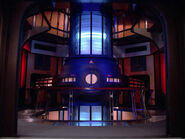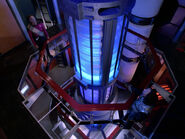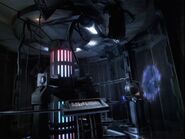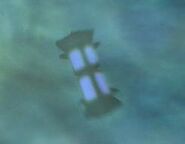Warp core, or warp core reactor, was the common designation for the main energy reactor powering the propulsion system on warp-capablestarships. During the 22nd century, warp reactors aboard NX-class starships were technically known as the "gravimetric field displacement manifold". (ENT: "Cold Front") A less common name for this core was antimatter reactor core. (TNG: "Booby Trap", display graphic)
The first Terran warp core was invented by Zefram Cochrane in 2061 and used in Humanity's first warp-capable vessel, the Phoenix, in 2063. The Phoenix's first flight on April 5th, 2063 was detected by a passing Vulcan survey ship, the T'Plana-Hath, who decided to initiate the first open contact between Humans and another species. The event was later considered a defining moment in Human history and celebrated as First Contact Day. (Star Trek: First Contact; VOY: "Friendship One", "Homestead")

The internal location of a Galaxy-class warp core
On Federation starships, the warp core usually consisted of a matter/antimatterreaction assembly (M/ARA) utilizing deuterium and antideuterium reacting in a dilithium crystal matrix, producing a maximum output of four thousand teradynes per second. (VOY: "Drone")
22nd-century warp cores were designed as oblong cylinders connected by pylon conduits directly into the warp nacelles. (ENT: "Broken Bow")
23rd century warp cores varied in design but still had the matter-antimatter reaction occur horizontally until at least 2269. On some ships such as the Crossfield and Constitution-classes, the warp core was not located in main engineering and was instead located in the dilithium energizer room, separate from main engineering (ENT: "In a Mirror, Darkly, Part II"; TOS: "That Which Survives", "The Alternative Factor")
In 2269, Federation warp cores had gained a radical upgrade. A new vertical segment was added to the dilithium crystal converter in main engineering, marking the transition to a new age of Starfleet warp core design. This new component allowed for increased power generation, and a large upgrade of the older horizontal mixing warp cores. (Star Trek: The Animated Series)
By 2270, most Federation warp cores were redesigned to consist of a large vertical warp core unit, doing away with the older obsolete horizontal cores. Located in the secondary hull, the matter and antimatter reaction plasma from the intermix chamber traveled the core through vertical conduits into the dilithium crystal converter, or main energizer as it was then called, (Star Trek II: The Wrath of Khan) with the resulting warp plasma energy directed to the nacelles through horizontal conduits leading out from the rear of the core. This advancement allowed for speeds of up to warp factor 12 on the old scale. At this point, the warp speed scale was revised for TNG to allow for higher warp speeds. (Star Trek: The Motion Picture)
As a safety precaution, the core could usually be physically ejected from the ship, should an event such as a catastrophic containment failure of the matter-antimatter reaction occur that could not be corrected. There were also some tactical uses for ejecting and detonating a core on purpose. The detonation could, for example, be used to neutralize the cascade of a subspace tear or to push a ship away from the gravity well of a black hole. (TOS: "That Which Survives"; TNG: "Cause And Effect", "All Good Things..."; VOY: "Cathexis", "Day of Honor", "Renaissance Man"; Star Trek: Insurrection; Star Trek; LD: "The Stars At Night")
Antimatter containment was achieved through the use of magnetic fields, which guided and directed the antimatter through the antimatter integrator to injector coils, which precisely compressed and streamed the antimatter into the form which entered the intermix chamber. Deuterium, stored in the ship or attracted by the Bussard collectors, was funneled in a stream from the opposite deuterium injector. The resulting energy plasma molecules entered the lattice matrix of the crystallized dilithium chamber, reacting within it and releasing a tuned energy stream in the form of electro-plasma, a highly energetic form of plasma. The electro-plasma was carried by magnetic plasma conduits throughout the power transfer system. In the Federation power transfer grid, this was the electro-plasma distribution network, comprised of EPS conduits and EPS taps. The most energized stream created was the warp plasma, which exited in twin power transfer conduits connected to the warp nacelles. (ENT: "Cold Front", "These Are the Voyages..."; Star Trek: Insurrection)
By the 24th century the dilithium crystal converter and matrix was replaced by a dilithium chamber matrix and articulation frame housed directly inside the matter-antimatter intermix chamber in a vertical warp core. (TNG: "The Best of Both Worlds", "Relics")
Dilithium crystals were also used in Klingon warp reactions in the 23rd century to generate energy at sufficient levels to enable warp flight. In the late 24th century, Klingon reactors used a tritium intermix, a feature not included in Federation and Romulan ships of the same era. (DS9: "When It Rains...") On Romulan starships, a completely different approach was used; an artificial quantum singularity in the warp core harnessed the energy necessary to power warp flight. (TNG: "Timescape")
Warp cores on starships left resonance traces, allowing for the ability to track vessels. (VOY: "Caretaker")
A warp core could be towed at warp using a tractor beam if calibrated properly. (VOY: "Day of Honor", "Renaissance Man")
When a warp core went offline, deuterium was a vital fuel to support the basic functions of a ship's auxiliary fusion reactors and impulse drive. Warp cores from shuttlecraft and shuttlepods could augment power, if necessary. (VOY: "The Void")
Warp cores emitted a thrumming sound, audible through much of the ship, that some Humanoids found soothing, gentle, or otherwise pleasant. (LD: "Terminal Provocations"; SNW: "Spock Amok", "Those Old Scientists")
Gallery[]
(alternate reality, 2259)

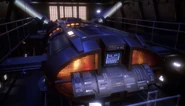
,_warp_cores.jpg/revision/latest/scale-to-width-down/185?cb=20091116110822&path-prefix=en)
,_warp_core_exterior.jpg/revision/latest/scale-to-width-down/185?cb=20130831124557&path-prefix=en)
,_warp_core_interior.jpg/revision/latest/scale-to-width-down/185?cb=20150911235347&path-prefix=en)





